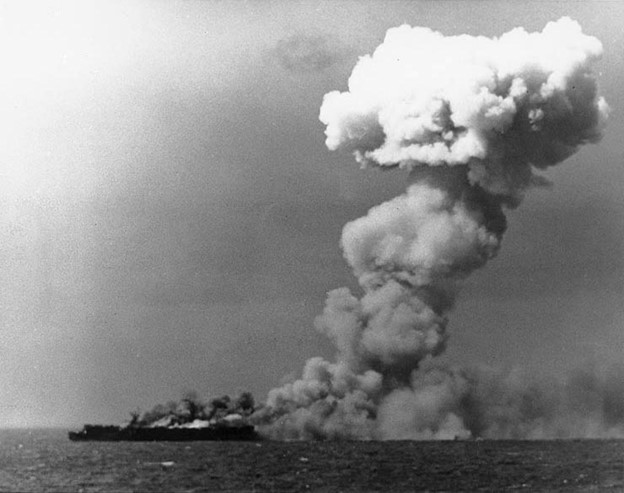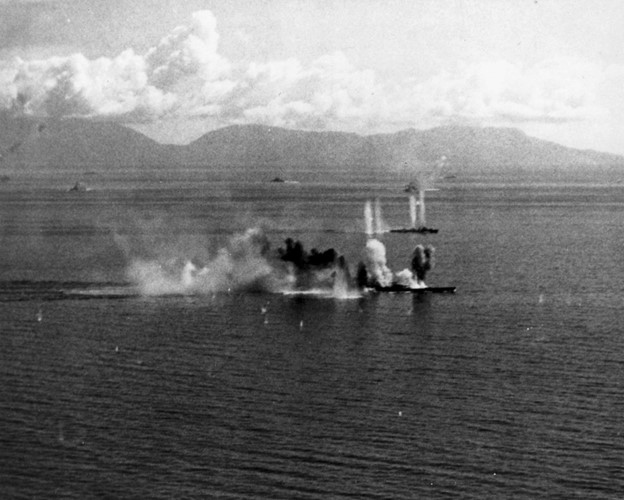Battlefield Chronicles: Battle of Leyte Gulf

The Battle of Leyte Gulf, fought between October 23 to 26, 1944, was the largest and one of the most decisive naval battles of World War II. With some 200,000 sailors involved, it might be the largest naval engagement in history. This monumental clash occurred in the waters surrounding the Philippine island of Leyte and marked a pivotal moment in the Pacific Theater. With its complex array of naval engagements, the battle ultimately led to a resounding victory for the Allied forces, further weakening the Japanese Empire and hastening the war's end.
 By the fall of 1944, Japan's imperial ambitions faltered, and the Allies were steadily advancing towards the Japanese home islands. The strategically important Philippines was a primary target for the Allies, as its capture would facilitate the liberation of other Southeast Asian nations and disrupt Japan's supply lines.
By the fall of 1944, Japan's imperial ambitions faltered, and the Allies were steadily advancing towards the Japanese home islands. The strategically important Philippines was a primary target for the Allies, as its capture would facilitate the liberation of other Southeast Asian nations and disrupt Japan's supply lines.
The Battle of Leyte Gulf unfolded as part of the larger operation that aimed to recapture the Philippines. American forces, under the command of Gen. Douglas MacArthur, initiated the operation with the invasion of Leyte on October 20, 1944. However, Japan was determined to defend its territory and deployed its remaining naval strength, known as the Center Force, to counter the Allied advance.
The battle was actually composed of four key engagements. The first was the Battle of Surigao Strait. This nighttime confrontation took place during the early hours of October 25, 1944, when the American 7th Fleet, led by Rear Adm. Jesse Oldendorf, ambushed the Japanese Southern Force as it attempted to enter Leyte Gulf. Employing a classic "crossing the T" formation, the American battleships unleashed a devastating barrage, crippling the Japanese. The battle resulted in the complete destruction of the Japanese battleships Yamashiro and Fuso, effectively eliminating any naval threat from the southern direction.
 Meanwhile, the Japanese Center Force, commanded by Vice Adm. Takeo Kurita, pressed on toward Leyte Gulf. On October 25, 1944, this force encountered the American escort carriers and their supporting ships in the Battle of Samar. Outnumbered and outgunned, the American vessels displayed remarkable courage and resourcefulness. They launched a desperate counterattack, deploying aircraft and employing evasive maneuvers to fend off Kurita's superior Fleet. While the Battle of Samar was a tactical victory for the Japanese, the heroic efforts of the U.S. escort carriers and their crews disrupted Kurita's advance. They forced him to withdraw, saving the invasion force at Leyte.
Meanwhile, the Japanese Center Force, commanded by Vice Adm. Takeo Kurita, pressed on toward Leyte Gulf. On October 25, 1944, this force encountered the American escort carriers and their supporting ships in the Battle of Samar. Outnumbered and outgunned, the American vessels displayed remarkable courage and resourcefulness. They launched a desperate counterattack, deploying aircraft and employing evasive maneuvers to fend off Kurita's superior Fleet. While the Battle of Samar was a tactical victory for the Japanese, the heroic efforts of the U.S. escort carriers and their crews disrupted Kurita's advance. They forced him to withdraw, saving the invasion force at Leyte.
The final phase of the Battle of Leyte Gulf unfolded around Cape Engaño, where American carriers under Adm. William "Bull" Halsey lured the Japanese Northern Force away from the Leyte Gulf. This diversionary tactic convinced the Japanese that they were facing a more substantial threat than they actually were, as Halsey's carriers were faster and more maneuverable than the battleships and heavy cruisers of the Northern Force. As a result, Halsey's decoy maneuver drew the Northern Force away from the gulf, allowing the invasion to proceed.
On October 26, 1944, the remnants of the Japanese Fleet retreated. Although the Japanese had inflicted some damage on the American forces, they had failed to disrupt the Leyte invasion, and their naval power had been severely diminished. The battle marked a significant turning point in the Pacific War, as it effectively crippled Japan's ability to challenge Allied naval supremacy.
The Battle of Leyte Gulf remains a testament to the courage and determination of the men who fought on both sides. It showcased the adaptability and resourcefulness of the American forces, who, despite facing superior numbers, managed to secure a decisive victory. For Japan, the battle was a devastating blow, hastening the decline of its Empire.
The Battle of Leyte Gulf is remembered as a crucial moment in World War II, where the tide of the Pacific War definitively turned in favor of the Allies. The American victory at Leyte wasn't without casualties. Though the U.S. Navy sank 28 enemy ships for 12,000 casualties, it lost 12 ships of its own, with 3,000 American casualties.